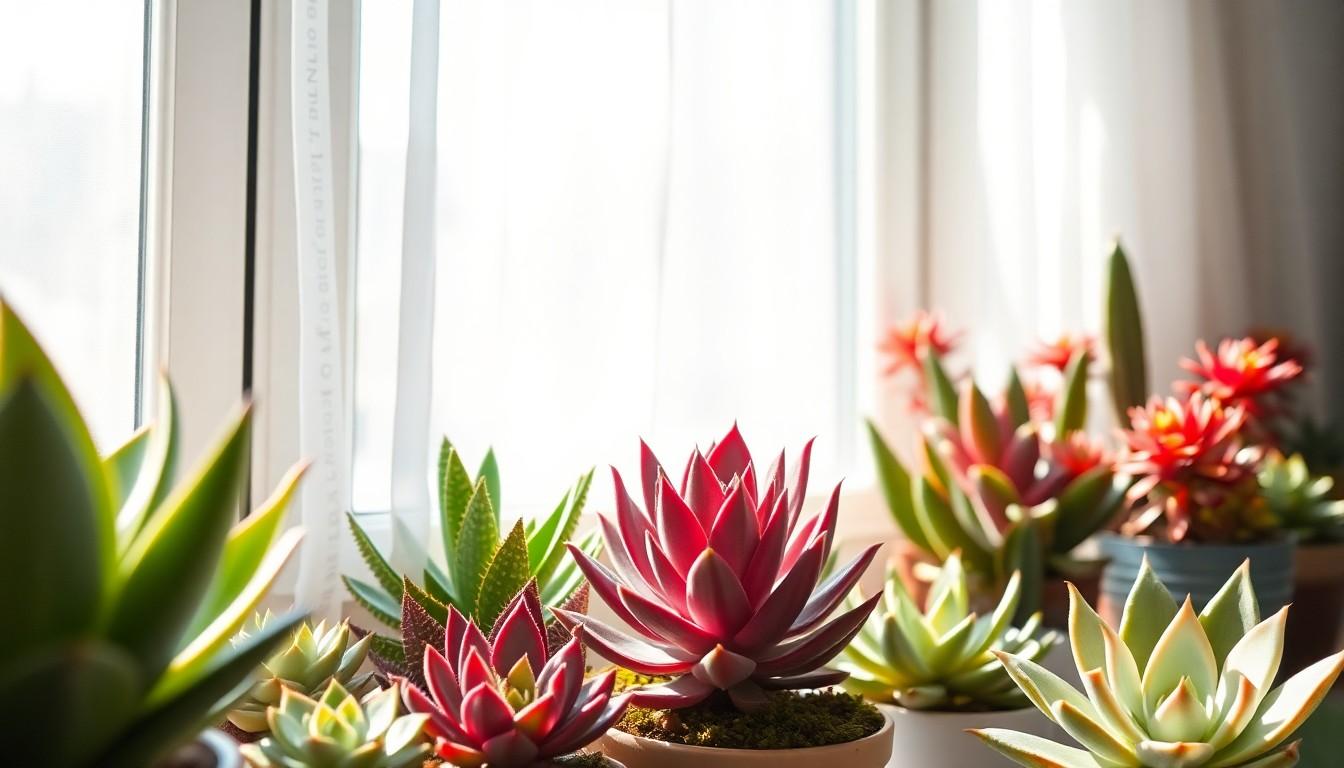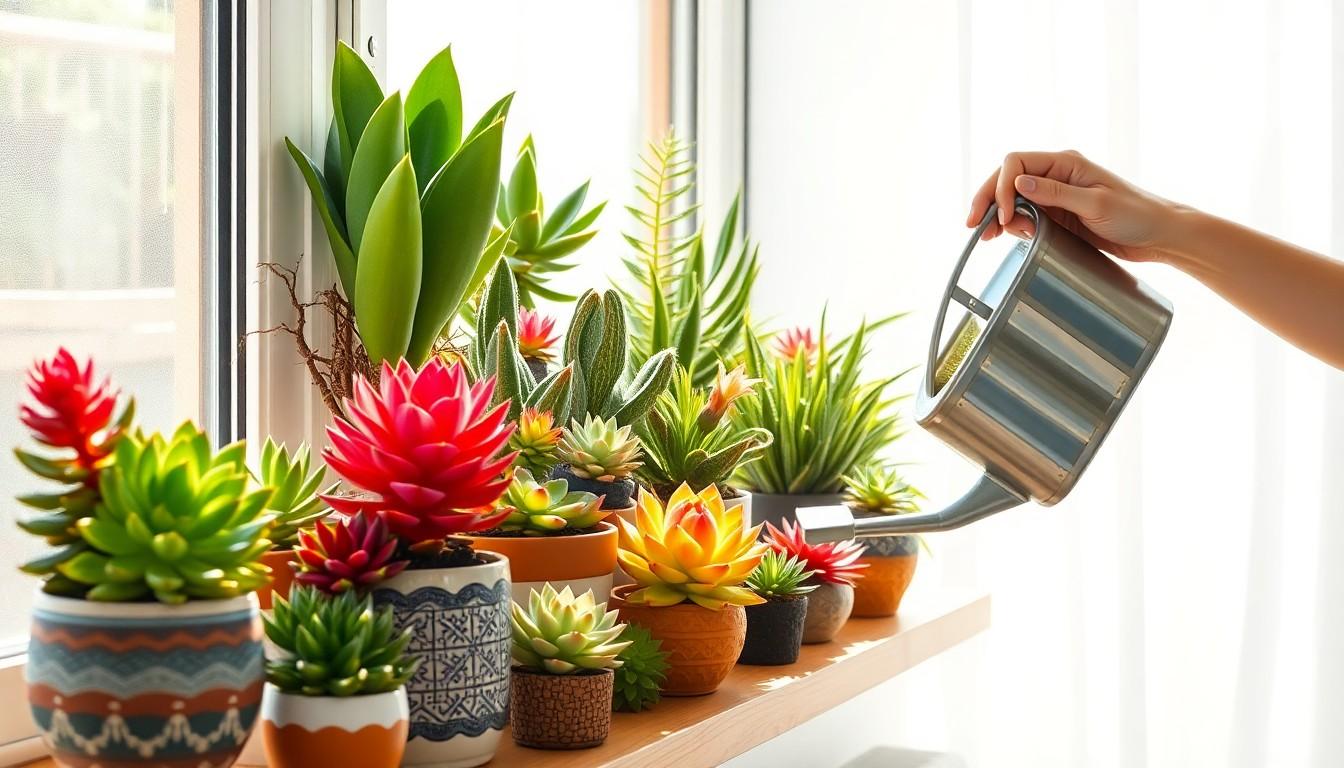Succulents are the ultimate low-maintenance houseplants, perfect for anyone who wants to add a touch of green without the guilt of neglecting a high-maintenance diva. These little wonders thrive on neglect, making them the perfect companions for those who can’t tell a watering can from a coffee mug. With their quirky shapes and vibrant colors, they’re like the cool kids of the plant world—always ready to brighten up a dull corner.
Caring for succulents indoors is easier than convincing a cat to take a bath. With just a few simple tips, anyone can keep these charming plants happy and thriving. From choosing the right pot to mastering the art of watering (hint: less is more), it’s time to unleash the inner plant parent. So grab your favorite mug—just not the one you use for watering—and let’s dive into the succulent care secrets that’ll turn any indoor space into a lush oasis.
Understanding Succulents
Succulents thrive in various indoor environments, combining beauty and low maintenance. These plants store water in their leaves, stems, or roots, allowing them to survive in arid conditions.
What Are Succulents?
Succulents are botanical varieties known for their thick, fleshy parts that retain moisture. This feature provides them with the ability to withstand dry periods. Members of the Crassulaceae family often fall into this category, showcasing a wide array of shapes and sizes. Originating from arid regions, succulents adapted to conserve water, making them ideal for indoor cultivation.
Common Types of Indoor Succulents
Several popular succulents enhance indoor spaces with their unique aesthetics. Echeveria stands out with its rosette shape and colorful foliage. Aloe vera, also a favorite, not only beautifies but offers medicinal benefits. Jade plants, often considered symbols of good luck, add a lush green touch. Another option includes snake plants, known for their air-purifying qualities. Each type brings distinct characteristics, offering homeowners diverse choices for their green decor.
Light Requirements

Succulents thrive under specific lighting conditions that are essential for their health and growth. Understanding these needs ensures vibrant, flourishing plants indoors.
Best Lighting Conditions
Bright, indirect sunlight serves as the optimal lighting condition for succulents. Many varieties like Echeveria and Aloe vera flourish when placed near a south or west-facing window. Direct sunlight can cause sunburn on their leaves, so filtered light is preferred. Using sheer curtains can diffuse strong rays while allowing adequate brightness. Alternately, artificial grow lights can supplement natural light, especially during winter months, providing an ideal spectrum for growth. Aim for at least six hours of light daily to keep these plants happy.
Signs of Insufficient Light
Plants often display signs of inadequate light, such as etiolation, where stems become long and leggy in their search for more sun. Leaf drop may also occur, indicating stress due to low light levels. In some cases, leaves may fade in color or develop a dull appearance. Experimenting with different locations can help identify suitable light exposure. Regularly assessing the plant’s condition allows for timely adjustments to its environment, ensuring optimal light levels for health and vitality.
Watering Practices
Proper watering is crucial for maintaining healthy indoor succulents. Discover effective techniques to ensure your plants thrive.
How Often to Water
Watering frequency for succulents varies based on environmental conditions. Factors such as light exposure, temperature, and humidity influence needs. Generally, succulents require watering every 1-3 weeks. During warmer months, they may need more frequent watering, while in colder months, less is suitable. Checking the soil is vital; if it’s completely dry 2 inches down, it’s time to water. Avoid routine schedules; instead, assess individual plant needs and conditions.
Signs of Overwatering
Overwatering poses a severe threat to succulents. Yellowing leaves often indicate excess moisture. Wilting or mushy leaves signal root rot, a common consequence of overwatering. The presence of brown spots also reflects poor drainage or consistent saturation. Additionally, an unpleasant smell from the soil may suggest decomposition. To prevent these issues, always use well-draining soil and pots with drainage holes. Adjust watering practices based on seasonal changes and plant responsiveness.
Soil and Potting
Proper soil and pot selection play crucial roles in maintaining healthy indoor succulents. These elements contribute to a thriving environment that supports your plants’ unique needs.
Choosing the Right Soil
Succulents thrive in well-draining soil. A suitable soil mix contains components like potting soil, coarse sand, and perlite or pumice. These materials promote airflow and drainage, preventing water retention that can cause root rot. Specialized succulent or cactus mixes are readily available and offer an excellent option. Regular potting soil may retain too much moisture, which isn’t ideal for these plants.
Pot Selection Tips
Opt for pots that include drainage holes, allowing excess water to escape easily. Terracotta pots are popular for their breathability and ability to absorb moisture. Various sizes suit different succulent types. A container that’s too large can retain excess moisture, leading to potential issues. Conversely, smaller pots allow for better root management and healthier growth. Adding a layer of gravel to the bottom can enhance drainage, ensuring optimum soil conditions for indoor succulents.
Fertilization Techniques
Fertilization plays a key role in maintaining the health of indoor succulents. Understanding when and how to fertilize can enhance growth and vitality.
When to Fertilize
Fertilization typically occurs during the growing season, which spans from spring to early autumn. Apply fertilizer once a month during these active months for optimal results. Reducing or halting fertilization during winter months is essential since succulents enter a dormant phase. Observing plant growth can guide fertilization frequency; lush growth signals an adequate supply of nutrients. Always consider individual succulent varieties, as specific requirements vary among species.
Recommended Fertilizers
Opt for diluted liquid fertilizers designed for succulents or cacti. Products with balanced NPK ratios, such as 10-10-10, serve succulents well. For a slow-release option, choose granular fertilizers formulated for succulents, applying them according to package instructions. Organic options, like worm castings or compost tea, offer a gentle nutrient boost while supporting soil health. Ensure fertilizers are applied in moderation; too much can lead to salt buildup, harming the plants.
Conclusion
Caring for indoor succulents can be a rewarding experience that adds life and beauty to any space. With their low-maintenance nature and unique characteristics, these plants thrive when given the right conditions. By focusing on proper light exposure, watering techniques, and suitable soil and pot selection, anyone can cultivate a healthy succulent collection.
Regularly assessing their environment and adjusting care routines ensures these resilient plants remain vibrant. Embracing the art of succulent care not only enhances indoor aesthetics but also fosters a deeper connection with nature. With a little attention and love, succulents can flourish and transform any home into a lush oasis.

